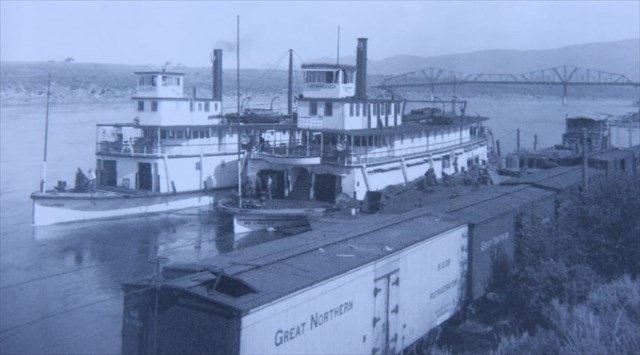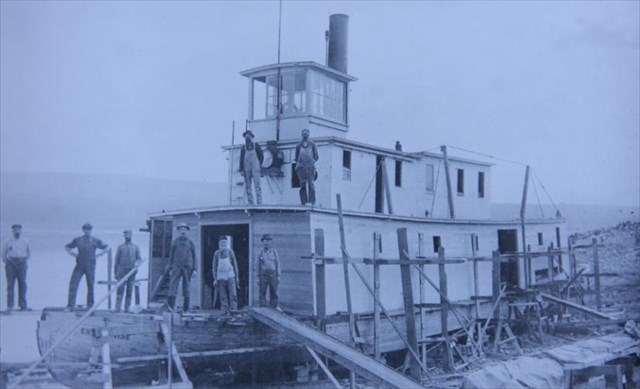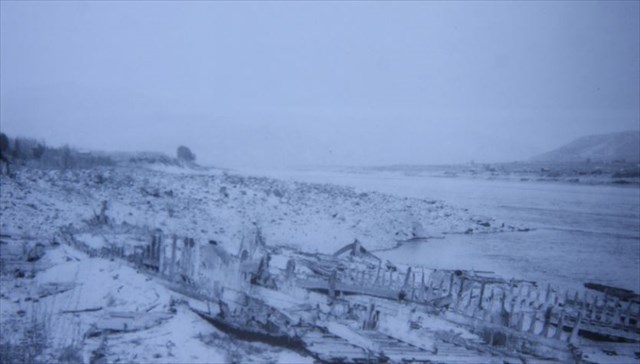
From 1890-1914, Upper Columbia River steamboat traffic was an important part of the development of our area, mainly from the Okanogan River down to Rock Island and then on down to Pasco. The first railroad tracks came to Wenatchee in 1892. Sternwheelers brought shipments from upriver to railroad cars to be shipped across the country, as well as returning shipments upriver: wheat in large quantities from the Big Bend Region, farm produce, lumber, machinery, other commodities/supplies and many passengers.

Wenatchee was quite isolated in the mid 1880's, with no railroad and no steamboats. Even though the residents hoped for it, there was not enough monetary reasons for railroad or river navigation until the sudden and sensational discovery of rich silver mines in Conconully Valley. This motivated the plans for a steamboat service on the Upper Columbia river.
Captain W.P. Gray was secured to take the first trip: A boat was built that he said was not made for fast rapids and wouldn't work, but the company did so anyway. The hardest parts of the river were navigating Priest Rapids and Rock Island Rapids. After a dangerous and long trip down the river in 1888 (two days at Priest Rapids with several lines to navigate the rapids), where multiple lives were nearly lost, it was almost decided that steamboat service was impossible (also needed were more powerful boats to get by the rapids without using lines).
In 1890, the legislature appropriated funds for limited improvement below Wenatchee, and also for a study of the river from Canada to Wenatchee. This enabled sternwheeler businesses to go forward. Over the next 21 years, improvements were conducted up and down the Columbia River, costing hundreds of thousands of dollars. These improvements mostly consisted of blasting rock formations under the water to make a path for the boats.
Even after improvements, there were more losses and damages to boats, and eventually a landing was created above Rock Island Rapids and the cargo and the people headed for Ellengsburg taken by wagon over Colockum Pass.
During extremely cold spells, workers would dynamite the ice so the sternwheelers could navigate. Sternwheelers were grounded by ice an average of eight days a year. Many sternwheelers were destroyed over time, from either sinking at dock, fires, or destruction on the river. Entiat Rapids seemed to be the biggest offender. Sometimes the ships would be rebuilt, although later the rebuilt ships could become damaged or destroyed. When the sternwheelers were damaged, the cargo would often be ruined, although few people ever died - partly because there were usually other sternwheelers in the vicinity who could pick up the crew and passengers.
The most famous local steamboat captain was Captain Griggs. He formed the Columbia and Okanogan Company (after buying up a previous company), which eventually bought out other companies. C&O was the biggest sternwheeler company on the Upper Columbia river, partly because Griggs was friends with the founder of the Great Northern Railroad, J.J. Hill. Griggs started out in the steamboat industry on the Mississippi and knew many notables, including Samuel Clemens (Mark Twain). There is a statue of Captain Griggs near the cache location.
The steamboat yard at the base of Fifth St. was constructed in 1896, where fifteen boats were built by 1917. The steamboat yard extended all the way up to Piere St. (SW of Sternwheeler Park). There was a blacksmith shop, sail and paint shop, lumber storage building, watchman's house, and office.

A swimming pool, the Piper Natatorium, was built just west of the boatyard in 1916, where the Chelan County P.U.D. headquarters are now. Abram A. Piper built the swimming pool as an alternative for his sons and the community, rather than swimming in the Columbia where children sometimes drowned. The pool was closed down in 1936, when the city of Wenatchee built a pool, the Hughes Memorial Pool, closer to the river at the foot of Fifth St.
Originally, the city's drinking water supply came from the Columbia, and horse drawn wagons delivered water to homes and businesses for 25 cents a barrel. The city's earliest pumping plant and reservoir were built at the foot of Fifth St. in 1907, just south of the steamboat yard.
In the early 1890's, with much controversy over the location, a side track was extended down to the foot of Chehalis St. and was used to load goods from freighter to steamboat and sacked wheat from boat to freighter. In later years, boxed fruit was added from upriver. This was the main landing site for sternwheelers, but is now covered in water due to the river rising after the dams were put in. At some point, a rail spur was also built down to the Fifth St. landing.
The completion of the Wenatchee to Oroville section of the railroad in 1909 spelled the beginning of the end of the Upper Columbia steam-boating traffic.
On July 7 (8?), 1915 (100 years ago) carelessness and a stiff breeze combined for a fire at Sternwheeler Landing (next to the cache location) which virtually ended over 25 years of steam boating. The Okanogan, the Columbia, the Northstar, and the Chelan were destroyed. They were all docked together right here at the foot of Fifth St, below present day Sternwheeler Park. C&O fleet was said to have lost a fortune. There was no insurance. The steamboating industry on the Upper Columbia never really recovered. After 1915, the few remaining sternwheelers mostly carried passengers, with the last sternwheeler ending in 1942.

Some sternwheelers operating near Wenatchee over time:
Selkirk
Columbia
Chelan (Chelan was the fastest sternwheeler on the Upper Columbia, 125 long, and could hold 110 passengers.)
Okanogan
Thomas L. Nixon (Famous for ferrying locomotives and traincars across the Columbia at Rock Island, before the Rock Island railroad bridge was completed. The Nixon was known as the Train Ferry.)
North Star
Echo (The Echo took mail to the upriver communities.)
Camano
Wenatchee
Yakima
Alexander Griggs
W.H. Pringle
Gerome
Enterprise
Bridgeport